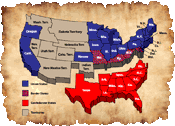Confederate Cavalry Facts
A cavalry regiment was organized in a similar fashion to the infantry and artillery. Cavalry regiments were composed of 10 companies of 100 to 110 troopers each. There were 5 squadrons in a regiment, a squadron being a combination of 2 companies. This was later changed and the regiments were divided into 3 battalions. A company was divided into "squadrons" for easy maneuvering on the field. The cavalry regiment was much more expensive to sustain while in service due to the amount of equipment carried by each cavalryman (carbine, saber, pistol, belt set, and equipment for the soldier's mount) and the requirement for horses and their care.
The role of the cavalry at the beginning of the Civil War was very limited. Horsemen of both armies were initially limited to patrolling and scouting, guarding supply trains and railroads, and providing escorts to generals. They were only used in battle as shock troops, a tactic which dated back to the Romans. The foot soldiers believed the cavalry to be "dandies on horseback" who never saw much fighting and always had the easy life. Certainly, the dash and spirit of the more flamboyant cavalry leaders provided the newspapers with many stories of harrowing rides and gallant duels in the saddle. Confederate troopers commanded by Maj. Gen. J.E.B. Stuart had the grandest reputations of being the best horsemen, ready to ride on a raid at a moments notice or rush to the front to do battle just as the tide was beginning to turn. Of course, truth was very different from the romantic descriptions of newspapermen. Soldiering on horseback was a hard life with plenty of danger.
The cavalry's military role had dramatically changed by 1863 and the armies were making use of their horse soldiers in more combat situations. Cavalry divisions were utilized by commanders as advance scouts and as a mobile fighting force. These new strategies culminated in the largest cavalry battle of the war fought on June 9, 1863 at Brandy Station, Virginia. Brandy Station was the opening clash of the Gettysburg Campaign.
Cavalry were dependent on fast movement so a cavalrymans's first priority was care of his horse.
Each cavalry regiment had a blacksmith who shod and cared for the animals in camp. On active campaign, a trooper had to look out for his own animal and care for it. If the horse was disabled, it was easier for a Union soldier to get a new mount from the herd which usually accompanied the army. Confederates brought their own mounts with them into service and woe be to the man whose horse pulled up lame or was injured. It sometimes meant the trooper became a foot soldier until another horse could be obtained. The armament of a typical cavalryman at Gettysburg included a light steel saber, a pistol and a carbine. By the time of the Battle of Gettysburg, breech loading carbines were standard issue in all Union cavalry regiments. The carbine version of this weapon appeared in the Army of the Potomac after Gettysburg and made a great difference in firepower. On the cavalryman's saddle was strapped his baggage which included a shelter tent, blanket, poncho, saddle bags for rations and a canteen.
Confederate cavalrymen traveled lighter than their Union counterparts and were not usually armed with the more modern carbines. Short, muzzle-loading carbines were more common in southern regiments, including imports from England. Some Confederate troopers preferred to leave their sabers behind and carried extra pistols instead of sabers, for close work. Southern arsenals attempted to mass produce breech loading carbines, even making copies of Union carbines made by the Sharps Rifle Company. Attempts at mass production of the weapon failed and southern cavalrymen relied upon a varied stock of captured and imported arms.
Cavalrymen could fight either mounted or on foot in a staggered skirmish line. Fighting on foot did eliminate some of the unit's firepower as one soldier was designated as a holder for 4 horses, including his own, while the other three troopers were detailed to the firing line.
The principal shoulder weapon of the cavalry was a short-barrelled carbine. These were effective out to 200 yards. Numerous designs appeared early in the war, and close to 20 different types were eventually adopted by Federal forces. They ranged from fairly simple single-shot breechloaders using a paper or linen cartridge and a percussion cap, to complex repeaters firing self-priming metallic cartridges. Calibers ranged from .44 to .54, and many carbines took specially made cartridges. Resupply of ammunition often proved tedious.
One mainstay of the cavalry on both sides was the Sharps. In production since the early 1850's, this .52 caliber arm was already known to be strong and reliable, and about 80,000 were purchased by the Federals. Even though a single-shot, its breech-loading mechanism allowed a trooper to get off up to 5 shots per minute, against possibly 3 from a muzzle-loading musket.

